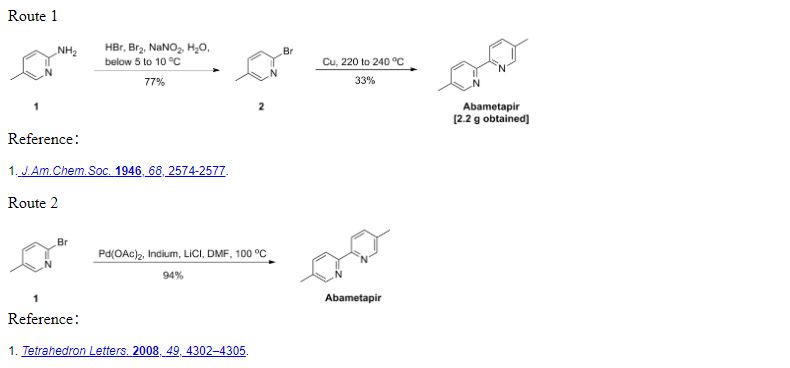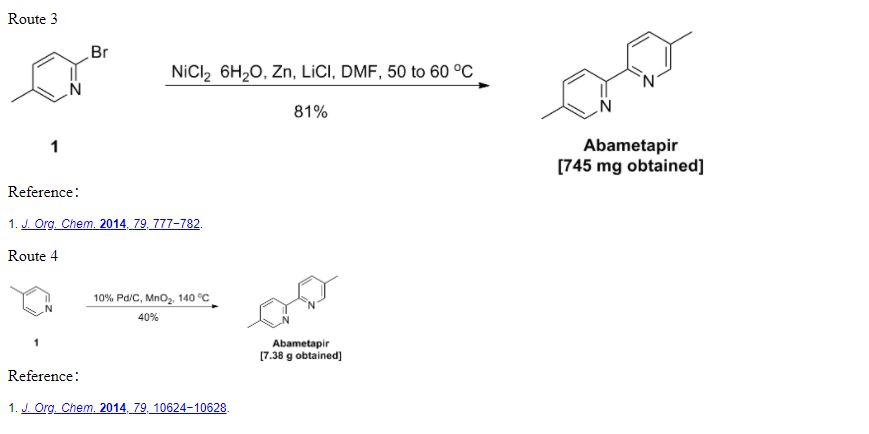
Abametapir
アバアバメタピル , абаметапир , أباميتابير , 阿巴甲吡 ,
5,5′-dimethyl-2,2′-bipyridine, 6,6′-Bi-3-picoline
- BRN 0123183
- HA 44
- HA-44
- HA44
| Formula |
C12H12N2
|
|---|---|
| CAS |
1762-34-1
|
| Mol weight |
184.2371
|
Xeglyze, FD APPROVED 24/7/2020
|
Pediculicide, Metalloproteinase inhibitor
|
|
| Disease |
Head lice infestation
|
|---|
- Originator Hatchtech
- DeveloperDr Reddys Laboratories; Hatchtech
- ClassAntiparasitics; Heterocyclic compounds; Pyridines; Small molecules
- Mechanism of ActionChelating agents; Metalloprotease inhibitors
- Registered Pediculosis
- 27 Jul 2020Registered for Pediculosis (In adolescents, In children, In infants, In adults) in USA (Topical)
- 18 Jun 2020FDA assigns PDUFA action date of 12/08/2020 for Abametapir for Pediculosis (Dr Reddy’s Laboratories website, June 2020)
- 31 Mar 2019Abametapir is still in preregistration phase for Pediculosis in USA
Abametapir is a novel pediculicidal metalloproteinase inhibitor used to treat infestations of head lice.4 The life cycle of head lice (Pediculus capitis) is approximately 30 days, seven to twelve of which are spent as eggs laid on hair shafts near the scalp.2 Topical pediculicides generally lack adequate ovicidal activity,2 including standard-of-care treatments such as permethrin, and many require a second administration 7-10 days following the first to kill newly hatched lice that resisted the initial treatment. The necessity for follow-up treatment may lead to challenges with patient adherence, and resistance to agents like permethrin and pyrethrins/piperonyl butoxide may be significant in some areas.3
Investigations into novel ovicidal treatments revealed that several metalloproteinase enzymes were critical to the egg hatching and survival of head lice, and these enzymes were therefore identified as a potential therapeutic target.1 Abemetapir is an inhibitor of these metalloproteinase enzymes, and the first topical pediculicide to take advantage of this novel target. The improved ovicidal activity (90-100% in vitro) of abemetapir allows for a single administration, in contrast to many other topical treatments, and its novel and relatively non-specific mechanism may help to curb the development of resistance to this agent.1
Abametapir was first approved for use in the United States under the brand name Xeglyze on July 27, 2020.6
Abametapir, sold under the brand name Xeglyze, is a medication used for the treatment of head lice infestation in people six months of age and older.[1][2]
The most common side effects include skin redness, rash, skin burning sensation, skin inflammation, vomiting, eye irritation, skin itching, and hair color changes.[2]
Abametapir is a metalloproteinase inhibitor.[1] Abametapir was approved for medical use in the United States in July 2020.[1][3]
Medical uses
Abametapir is indicated for the topical treatment of head lice infestation in people six months of age and older.[1][2]
History
The U.S. Food and Drug Administration (FDA) approved abametapir based on evidence from two identical clinical trials of 699 participants with head lice.[2] The trials were conducted at fourteen sites in the United States.[2]
The benefit and side effects of abametapir were evaluated in two clinical trials that enrolled participants with head lice who were at least six months old.[2]
About half of all enrolled participants was randomly assigned to abametapir and the other half to placebo.[2] Abametapir lotion or placebo lotion were applied once as a ten-minute treatment to infested hair.[2] The benefit of abametapir in comparison to placebo was assessed after 1, 7 and 14 days by comparing the counts of participants in each group who were free of live lice.[2]
SYN
Ronald Harding, Lewis David Schulz, Vernon Morrison Bowles, “Pediculicidal composition.” WIPO Patent WO2015107384A2, published July, 2015.


References
- ^ Jump up to:a b c d e “Xeglyze (abametapir) lotion, for topical use” (PDF). U.S. Food and Drug Administration (FDA). Dr. Reddy’s Laboratories. Inc. Retrieved 25 July 2020.
- ^ Jump up to:a b c d e f g h i “Drug Trial Snapshot: Xeglyze”. U.S. Food and Drug Administration (FDA). 24 July 2020. Retrieved 6 August 2020.
 This article incorporates text from this source, which is in the public domain.
This article incorporates text from this source, which is in the public domain. - ^ “Abametapir: FDA-Approved Drugs”. U.S. Food and Drug Administration (FDA). Retrieved 25 July 2020.
Further reading
- Bowles VM, VanLuvanee LJ, Alsop H, Hazan L, Shepherd K, Sidgiddi S, et al. (September 2018). “Clinical studies evaluating abametapir lotion, 0.74%, for the treatment of head louse infestation”. Pediatr Dermatol. 35 (5): 616–621. doi:10.1111/pde.13612. PMC 6175393. PMID 29999197.
External links
- “Abametapir”. Drug Information Portal. U.S. National Library of Medicine.
 |
|
| Clinical data | |
|---|---|
| Trade names | Xeglyze |
| Other names | Ha44 |
| AHFS/Drugs.com | Professional Drug Facts |
| License data |
|
| Pregnancy category |
|
| Routes of administration |
Topical |
| Drug class | Pediculicide, Metalloproteinase inhibitor |
| ATC code |
|
| Legal status | |
| Legal status | |
| Identifiers | |
| CAS Number | |
| PubChem CID | |
| DrugBank | |
| ChemSpider | |
| UNII | |
| KEGG | |
| ChEMBL | |
| PDB ligand | |
| CompTox Dashboard (EPA) | |
| ECHA InfoCard | 100.157.434 |
| Chemical and physical data | |
| Formula | C12H12N2 |
| Molar mass | 184.242 g·mol−1 |
| 3D model (JSmol) | |
///////Abametapir, 2020 APPROVALS, FDA 2020, Xeglyze, アバメタピル , абаметапир , أباميتابير , 阿巴甲吡 , BRN 0123183, HA 44, head lice
CC1=CC=C(N=C1)C1=CC=C(C)C=N1














